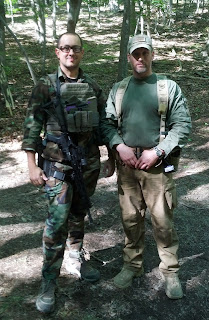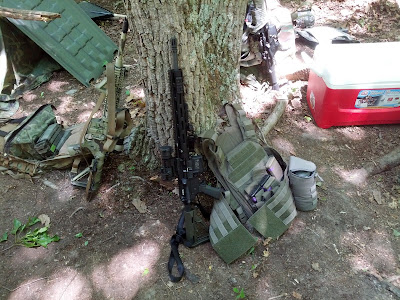May 25/26 Training Weekend – Fifth AAR
Max Velocity Tactical
Combat Rifle & Contact Drills – 25/26 May 2013
My Background
I am 33 years old I have been shooting since I was 15 years old and received a bulk of my rifle training through the military. I served as a Combat Engineer in the Army National Guard and been shooting the AR15 for all of my shooting career. I also spend a lot of my time on the range while training others as an NRA certified instructor. I consider myself in very good shape, I cycle about 150 miles a week in addition to running. I live in Northern Virginia and when I learned Max was offering training not even 2 hours away from me, I jumped all over the opportunity.
Regardless of your fitness level, it is up to you the individual to push yourself as hard as you want to in Max’s course. He is not a raving lunatic drill instructor but a passionate teacher who wants you to learn and learn well. I really got my heart rate up as I was moving at 100% whenever I was on on the range shooting along side my fellow students. A course like this gives you a dose of reality on how that gear really works and feels when you actually use it in an applied setting.
My equipment for the course consisted of AR500 steel plates in a Banshee plate carrier holding an EGL Monkey Stomper mag pouch, and an ITW fastmag. I built my rifle off of a stripped M&P lower with a BCM 16″ Mid-length upper using the VTAC handguard and topped off with an Aimpoint CompM2 sight. I also carried my 1911 in a safariland holster.
“Tactical” vs Tactical
While over the past few years there have been a lot of ‘tactical’ courses offered out there, I have never taken an interest in them. I can sum it up in two words to explain why: Square Range.
There is only so much that can be done on the square range. I cannot completely blame instructors as there is a fear of lawsuits and a lot of facilities are not setup for this level of training. I have noticed within the gun community (especially online) is the thought that attending these courses, or even a lot of them, transforms a shooter into an individual that can operate in the field as a soldier. I’m not saying that this is explicitly stated, but there is are a lot of implications made by those who attend courses and feel they are ‘all set.’
The square range can be good to teach fundamentals and get a shooter familiar with his weapon. Short of that, if you want to train in how to use your weapon in combat, you need to replicate that environment as close as possible. Jumping around the range, walking around barrels and shooting 1,000 or even 2,000 rounds in a weekend just creates noise and shreds paper. I think I expended at most 300 rounds of ammunition in his course. You are putting down accurate fire, not spraying rounds on rapid fire, marksmanship counts.
If you want to have any chance of surviving an exchange of gunfire you need a team. Not only do you need a team, you need a team that has been trained and knows what it is doing. It is certainly exemplified in Max’s course.
Max stepped up to the plate and in an incredibly short period of time put together a great environment for his training. We trained on two separate courses of fire over the course of the weekend. Max utilized the crawl, walk, run style of teaching. On all his ranges he has invested in great pop-up targets that can be remotely controlled.
The first range was used to introduce students to the mechanics of RTR drills, reacting to targets front, left and right and then built upon that to working with a partner. The second range is the ‘Jungle Walk’ where there is a loosely defined path to patrol in but you can be ‘ambushed’ by popup targets to the sides or directly in front. This was a very challenging course because of contrasting light and shadows from the foliage. Even a black and white paper target can be hard to detect moving among the foliage. We continued building our skills in working in a team till the conclusion of the course on Sunday where we operated as a 4 man group. Max definitely threw some curve balls at us too. When we were rallying after breaking contact and set up a hasty ambush he flipped up another pop-up target. Lucky for all of us by this point, all the students were really dialed in and successfully engaged without hesitation.
The jungle walk also illustrated a good lesson, people can get too caught up and spend a lot on the latest and greatest camouflage patterns. Just black and white moving targets were hard to detect in the woods. Good natural tones that match your surroundings can help you blend a great deal. I used my old army issue woodland BDUs along with an olive drab plate carrier and I think that pattern works quite well for the Virginia area.
Max is a great instructor and my two days with him surpassed the quality of a lot of my training I experienced in the Army. I truly cannot stress that enough. Through reading Max’s book, “Contact!”, his blog postings and now training with him in person I can say he is an incredibly experienced, accomplished and thoughtful professional. He is also a class act, enjoying a proper cup of PG Tips during the breaks and treats everyone as equals and professionals.
I highly recommend Max’s instruction without any reservation and encourage anyone reading this to attend. The knowledge and experience is truly priceless.
Lessons Learned:
- You need a team, teamwork wins, individuals loose.
- Keep your head on a swivel, you not only need to scan for potential threats, but also where you’re going to dive to cover when engaging.
- When making contact, return fire and TAKE COVER!
- When you have a stoppage, don’t fiddle around and be a target, take cover!
- Make sure you communicate with your team. During the solo runs on Range 1, I had to keep reminding myself to communicate and not get sucked into tunnel vision/thinking with shooting.
- Do as much PT as you can. When you think you’ve done enough, do more. The coolest kit in the world cannot make up for lack of PT.
James
Loudoun County, VA



